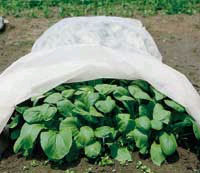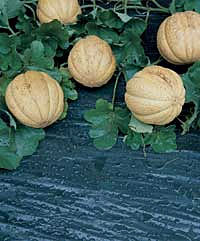Contending with the elements
Techniques for stretching the harvest
Resources
Contending with the elements
Few gardeners are content with the growing season they're dealt by Mother Nature. In the North, that season can be as short as 90 days -- barely enough time to ripen tomatoes or melons. In the South, drought and intense heat can limit gardening activity to the spring and fall months.
 |
Seedlings grow much more quickly under a protective layer of garden fabric

|
The good news is that by using a few simple season-extending techniques and plant-protection devices, you can shield your plants from extremes of weather, and stretch your gardening season by two, three or even six months.
Wind. If the plants in your garden must battle a strong wind, they will be using most of their energy to simply survive, rather than developing strong root systems and putting on healthy growth. There are several ways to protect your garden from wind: Build a wood fence; plant some shrubs; or put up windbreak netting. Your goal is to reduce the wind speed, not to create a dead calm.
If there's a prevailing wind direction, a fence on that side of the garden may be all that's needed. If a permanent fence or hedge requires more of a time or financial commitment than you are ready to make, try a temporary plastic mesh fence or cover your plants with a polypropylene garden fabric
 . Seedlings grown under the shelter of garden fabric will often put on twice as much growth as control plants.
. Seedlings grown under the shelter of garden fabric will often put on twice as much growth as control plants.
 |
| Cover cold spring soil with mulch and you can boost the soil temperature by several degrees.
|
Cold Soil. If you protect your garden over the winter with a thick layer of mulch, be sure to pull the mulch off the planting beds in early spring to expose the soil to the sun. Raised beds are another way to warm the soil more quickly. Covering cold spring soil with black plastic can also boost soil temperature by several degrees. The plastic can be left on all season or removed prior to planting.
Combining black plastic mulch on the soil with a clear, slitted plastic tunnel overhead, will raise soil temperatures enough to get melons and other heat-lovers off to a fast start. In the fall, covering plants with polypropylene fabric will retain heat and keep soil temperatures several degrees warmer. This can give heat-loving crops such as peppers, okra and tomatoes a couple extra weeks to ripen.
Sun and Heat. Hot weather can be just as challenging as cold weather. Young plants can be stressed and stunted by excessive heat; salad greens turn bitter and go to seed, and getting seeds to germinate can be very difficult. Shade netting keeps plants and soil cool and helps retain moisture. It can be laid right over wire hoops or a movable wooden frame. A piece of wood lathe attached to a frame can serve the same purpose.
Frost. For most gardeners, frost is a limiting factor in both spring and fall. One night of 32 degrees F. will usually put an end to all but the hardiest of garden crops. Sheets, blankets and cardboard boxes are good emergency solutions, but garden fabric (or row covers) is far easier to handle and much more effective. These fabrics are available in a variety of thicknesses, and some, such as GardenQuilt
 , will protect to temperatures as low as 25 degrees F.
, will protect to temperatures as low as 25 degrees F.
Cold frames and portable greenhouse structures can offer even greater cold protection, allowing you to extend your harvest season of cold-weather crops right through the winter.
Techniques for stretching the harvest
Start by considering your local climate, how much you want to stretch the season, and how much time you are willing to invest. If you live in a cold climate and want to extend your harvest season year-round, you will probably need to invest in a portable greenhouse and be prepared to provide daily attention. On the other hand, if you just want a few extra weeks of ripe tomatoes in the fall, and salads a couple of weeks earlier in the spring, the solution is easy and inexpensive.
The 30-Day Stretch
Provide your plants with a sheltered growing environment that minimizes stress. When transplanting your seedlings, try to keep them covered with garden fabric
 for the first couple of weeks. With protection from hot sun, cold wind, frost and insects, your plants will get off to a much faster start. Garden fabrics made of spun polyester or polypropylene are sun-, air-, and water-permeable, which means excess heat can escape and rainwater can pass through. Checking your plants weekly, for water and weeds, is all the attention that's required.
for the first couple of weeks. With protection from hot sun, cold wind, frost and insects, your plants will get off to a much faster start. Garden fabrics made of spun polyester or polypropylene are sun-, air-, and water-permeable, which means excess heat can escape and rainwater can pass through. Checking your plants weekly, for water and weeds, is all the attention that's required.
Individual plants can also be covered with plastic milk jugs, coffee cans with the bottom cut out, or tomato cages encircled with clear plastic. Just be sure that the cover is vented, and that you stay on the lookout for signs of overheating. Another option: specially made covers called cloches, such as Hot Caps
 or Large Bell Cloches
or Large Bell Cloches
 .
.
The 60-Day Stretch
Using garden fabrics in both spring and fall can add a full two months to your harvest season. Use them in the spring as described above, but plan to use a heavier fabric in the fall, such as GardenQuilt
 , to retain soil heat and prevent frost from damaging the foliage.
, to retain soil heat and prevent frost from damaging the foliage.
Choosing the right plant varieties can make a significant difference too, since some varieties are specially suited to early- or late-season production. There are some varieties of broccoli, for instance, that thrive in cold spring soils, but go to seed quickly once warm weather arrives. There are other varieties that will tolerate heat, and still others that thrive in the low light conditions and cold temperatures of late fall.
A Stretch of 3 to 4 Months
In many parts of the country, cold frames, and movable greenhouses can extend your harvest almost year-round. Managing a protected growing environment in the face of widely fluctuating weather extremes is actually easier than you might imagine. The rewards -- salad greens in February and tomatoes right through Thanksgiving -- far outweigh the investment.
The key to success is to concentrate your energies on one small section of your garden that is close to the house. Focusing on a few crops is another way to increase your success. Salad greens and root crops are easiest. You'll find that a 3-foot-by-4-foot bed of greens can provide many months' worth of salads. Choosing the right varieties and following a continuous planting schedule is essential.
Like greenhouse gardening, growing under cover is an exciting new world with big rewards. Imagine having a salad bar with fresh, organic produce right outside your door, eight or ten months a year.
Resources
Favorite Books
The New Organic Grower's Four Season Harvest by Eliot Coleman (Chelsea Green, 1992).
Efficient Vegetable Gardening: Getting More Out of Your Garden in Less Time by Paul Doscher, Timothy Fisher and Kathleen Kolb (Globe Pequot, 1993).
Cold Climate Gardening by Lewis and Nancy Hill.

